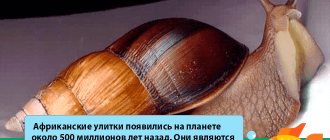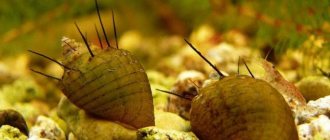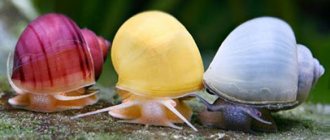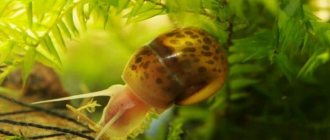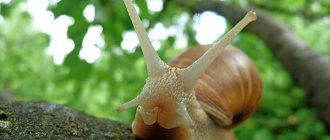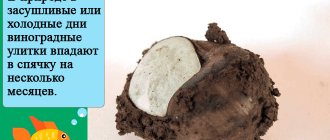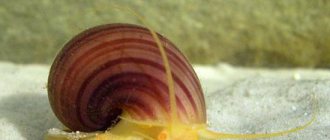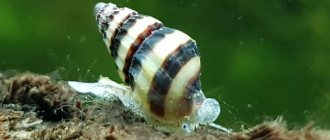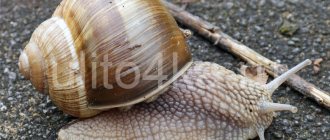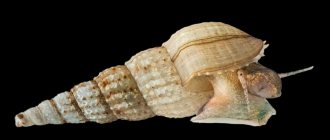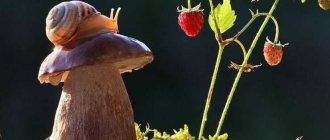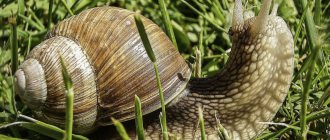When people get such exotic pets as snails, they, as a rule, have no idea what their pets are like, just as they have no idea about the structure of their body.
However, in order to correctly understand the needs of a snail, to understand its life and be able to organize the most comfortable living conditions for it, such knowledge is simply necessary.
Below we will try to give as complete an idea as possible of how these amazing creatures - snails - work.
No, don’t be alarmed: we won’t dive into anatomical details, just as we won’t torment readers with an abundance of Latin terms. We will only pay attention to individual parts of the snails’ body, thanks to which it will be possible to judge the state of the pet at the moment, what its mood is and, of course, the state of its health and well-being.
Snail (Gastropoda).
Description of the snail
In natural habitats, the length of the shell reaches up to 30 cm in length. And in captivity they grow up to 20 cm. The size of the mollusk depends on the conditions of detention. Read more about snail keeping here . In 1976, in the Republic of Sierra Leone, a local boy found the Achatina Achatina (tiger) snail. The size of the shell was 28 cm, it weighed 900 grams, and the body length exceeded 40 cm.[
Lifestyle
Achatina are predominantly nocturnal, although in wet weather they can crawl out during the day. Daylight hours are usually spent in secluded places, buried in the soil and become active only two hours after sunset. In the absence of food and decreased humidity, the snails burrow into the ground and hibernate until better times. The mouth is clogged with a film of mucus and calcium. During hibernation, Achatina loses up to 60% of its own weight. The snail is active at temperatures from +9°C to +30°C, and at temperatures from +2°C to +8°C it enters a state of torpor (hibernation). The duration of the active period of Achatina depends on the duration of the rainy season prevailing in the region. During hibernation, snails' heart rate decreases and gradual dehydration occurs.
Although Achatina fulica is a tropical snail, it can survive in cold conditions (even snow) through estivation (hibernation). Any location that provides adequate protection from light and drying out is used for hiding and hibernation. Fulics are able to climb walls and tree trunks to a height of up to 4 m. Achatina anticipates bad weather and hides in secret places in advance before a storm breaks out, etc.
Achatina have long-term memory: they can remember everything that happened within one hour, remember the location of food sources and return to them. Juveniles are more mobile and cover greater distances during the day and are capable of long-distance migrations. Usually they do not return to the same place to relax. Old snails, on the contrary, have a place where they prefer to rest and from where they crawl out in search of food, without moving more than 5 meters away from it. When the snails are transferred to the resting place of another Achatina (within 30 meters), they still come back.
Where does the giant snail live?
The homeland of Achatina is considered to be the territory of Africa from Ethiopia to Mozambique. Here the tropical climate persists all year round. At the beginning of the 19th century, the snail was introduced to many countries around the world. Here it adapted and began to actively reproduce. The Achatina snail is not a migratory species; humans contributed to its spread.
In Achatina's habitats there are many enemies who maintain the number of snails, preventing their uncontrolled reproduction.
Enemies of Achatina in nature
In nature, Achatina eats decaying plants and trees, tree buds and fallen leaves. As well as decaying remains and bones of animals. They need calcium to build their shells.
But the mollusk had no enemies in its new habitats. As a result of favorable conditions and a lack of predators, Achatina has become a disaster.
What do African snails eat?
What to feed Achatina? Of course with treats!
As mentioned above, this animal absorbs almost everything it encounters on its way. Shellfish especially love peanuts, beans, peas, cucumbers and melons. If fruits and vegetables are not available, snails do not disdain a variety of ornamental plants, tree bark, and even paint and plaster. It is this fact that worries Americans so much: as soon as this cute creature is allowed to multiply, the entire country will be left without vegetables and fruits.
Still, the best food for shellfish is lettuce, cucumbers, apples, bananas and cabbage. It is very important to prevent food spoilage - slugs will get sick if they eat rotten fruits and vegetables. Salty and sweet foods are also prohibited. An integral part of a snail's diet is calcium - it is needed to maintain the strength and health of the shell.
Babies are fed once daily, adults once a week.
Why are people sent to prison for keeping Achatina in the USA?
In 1966, a zoologist-naturalist brought several Achatina to Florida as exotic pets. But by some chance they ended up in the garden. Within 3 years, the snails became so prolific that they almost destroyed all the vegetation in Florida. It hit not only gardens and fields, but also old houses and dilapidated buildings. The snails ate the plaster off them, looking for calcium to grow a beautiful shell. Local Florida residents sounded the alarm. The purge of African guests lasted for 9 years. 19 million snails were captured and destroyed. Since then, a ban on the content of Achatina has been introduced in America.
Until now, in the United States, the African snail is caught and destroyed, and its owner is sent to prison for 5 years.
These countries were the first to declare the Achatina snail an agricultural pest:
In Babylon and Egypt, the snail was a symbol of eternity.
Queen Cleopatra used snail mucus to rejuvenate her facial skin. Read about Achatina therapeutic massage here .
See more similar articles:
Business plan for growing Achatina snails at home
Tips and like-facts for a novice snail breeder - there will be...
Back Forward 1 of 9
What do snails walk on?
Due to their specific lifestyle, gastropods have a very developed sole. Waves of muscle contractions pass along the sole, thanks to which the mollusk is able to move on almost any conceivable and inconceivable surface. On the surface you can also find two glands that secrete mucus. The snail needs mucus to make it easier for it to move on dry surfaces, ensuring proper gliding. Moreover, small snails move due to the beating of the cilia.
Few people know that the force with which a snail can stick to any flat surface, like glass, is very great. Under no circumstances should you tear the snail away from such surfaces, and if you have to do this, you should be careful and be very careful, first removing the edge of the sole using a non-sharp thin object. If this is not done, the owner will need to make much more effort to tear the pet off the surface. It is very easy to squeeze your fingers too tightly, which can cause the animal's shell to be damaged or completely cracked.
The organ that facilitates the movement of the snail is called the sole.
African clam in cooking
Residents of Africa, America and Southeast Asia used shellfish meat for food. Since the mid-19th century, Europeans have recognized snail meat as a delicacy. In Japan and France, Achatina is grown on special farms and eaten.
Achatina in cooking
Even the Romans and ancient Greeks, knowing about the dietary value of snails, recommended eating them. You can easily cook snail in your kitchen using our recipes.
100 g of snail meat contains 90 kcal.
Achatina meat contains micro- and macroelements, several essential amino acids, as well as vitamins A, B, E, etc. It treats rickets and tuberculosis, is useful for obesity and pregnancy, and eliminates the side effects of antibiotics on the body.
Care and conditions of detention
To provide Achatina with comfortable conditions, it is enough to equip a 10-liter warm terrarium. However, such a reservoir is only enough for one individual. And if the owner wants to raise a large snail, later he will need a more spacious container equipped with a lid so that the mollusk does not “go on the run” or other inquisitive pets do not get to it.
It is worth considering the following needs of Achatina:
- A series of small holes should be made in the container to allow oxygen to enter. The bottom of the tank is lined with soil material.
- Achatina adore the aquatic environment, so it is necessary to install a bowl of water or a small container in the terrarium in which the pet will bathe. But you should make sure that the water does not spill - mollusks do not like living in mud.
- Snails do not require special temperature conditions.
- Care should be taken to ensure suitable humidity in the terrarium. If the tank is too damp, the pet will move in the upper part of the tank; if the air is dry, it will often sit buried in the ground. With a normal indicator, the snail begins to be active during the day, crawling throughout the house, and at night wraps up its shell and hides in the ground. To increase humidity, sprinkle the bottom of the container with water.
- It is important to take care of the cleanliness of the “snail house”; it is thoroughly washed weekly. However, if the mollusk has laid a clutch, this event should be postponed. As for humidity, it is not recommended to change it during this period.
Achatina snail in cosmetology
Achatina snails are widely used not only in cooking, but also in cosmetology. European countries use it to produce cosmetics with anti-aging, wound-healing and therapeutic effects. African snail mucin is rich in collagen and elastin, allantoin and vitamins. Helps fight wrinkles and improves complexion. After Achatina cosmetology, the skin becomes soft and radiant, acne and pimples go away. Read more information about snail therapy here.
Where else is snail used?
In many countries, the African snail is used in fish farming and livestock farming, as cheap food for fish and chickens. She reproduces quickly and is very prolific. Therefore, Achatina is grown to create fertilizer, as well as for clinical and experimental laboratories.
I would like to note that the giant Achatina is a resident of tropical rainforests. Therefore, in many countries of Europe and the CIS, it will not be able to survive in natural conditions. Our climate is not the same as in the tropics.
Interesting facts about the Achatina snail
- Achatina fulica is a giant land mollusk. Zoologists have described 100 species
- The snail shell consists of 7-8 turns, reaching a length of 30 cm.
- Color: stripes of shades of black and brown
- The weight of the snail reaches 500 grams.
- Breathing: cutaneous, no gills
- The birthplace of the mollusk is Africa
- Habitat: rotting parts of plants and trunks of old trees
- Temperature range: from 23 to 26 degrees
- Reproduction - hermaphrodites
- Fertility: up to 5 billion eggs. Eggs are shaped like chicken eggs
- Moves at a speed of 1 cm per minute
- Diet: omnivorous - vegetables, fruits, cereals, plant residues, over 400 plant species
- Lifestyle: nocturnal animal
- Lifespan: 9 years
- Shellfish does not cause allergies
Answers for young owners - do snails have teeth, legs and eyes?
In addition to the ordinary street snails that our grandparents kept at home when they were little, exotic mollusks from Africa have now become extremely popular. Breeders provide melancholy beauties with cozy places in their apartments and country houses. Many owners not only admire the beautiful Achatina, but also breed babies for sale. Beginning breeders who are just studying African individuals often ask, where are the snail’s eyes and do Achatina snails have teeth? These and other interesting questions are answered by experienced zoologists with many years of experience.
Read more about the structure of the Achatina snail in our article.
The structure of the Achatina snail
Don’t be afraid, we won’t go into the anatomical jungle. Let's look at the main parts of the African snail's body. The mollusk consists of a shell, a sole and a pair of eyes.
External structure of the Achatina snail
A snail needs a shell:
- for protection from enemies;
- for protection against external damage;
- to protect internal organs from drying out.
The pattern, color and thickness of the shell depends on lighting, diet and humidity. Achatina's shell is so strong that it was used to smooth out tobacco leaves on huge tobacco plantations.
Structure and organs
Their anatomical structure is simpler than that of other animals, but their main advantage is their ability to quickly regenerate lost organs and tissues.
Internal structure of the cochlea:
| 1. Shell | 13. Puberty time |
| 2. Liver | 14. Penis |
| 3. Lung | 15. Vagina |
| 4. Anus | 16. Mucous gland |
| 5. Respiratory system | 17. Fallopian tube |
| 6. Eye | 18. Arrow pouch |
| 7. Tentacles | 19. Leg |
| 8. Cerebral ganglion | 20. Stomach |
| 9. Radula | 21. Kidney |
| 10. Mouth | 22. Mantle |
| 11. Croup | 23. Heart |
| 12. Salivary gland | 24. Efferent vessel |
Sink
The shell is based on calcium compounds and organic substances, so it is a reliable protection for the part of the body where the internal organs are concentrated. It also saves the animal from external enemies and drying out. The shell has a spiral shape and consists of 7 - 10 curls. The largest individuals can have up to 15 curls. Basically, the shell twists clockwise. Shells twisted in the opposite direction are very rare.
In humid areas, Achatina shells are thinner and more transparent. Individuals living in arid zones boast a heavy and durable shell.
Respiratory system
The animal has one lung, formed from the mantle cavity. At the edge of the shell there is a breathing hole through which it draws in air. Achatina can also breathe through the skin.
Heart
The cardiovascular system of gastropods includes:
- heart,
- open circulatory system.
The heart has developed muscular walls. Its job is to rhythmically pump blood into the blood vessels. The heart beats rhythmically and pumps blood with such force that it reaches the farthest parts of the body. The circulatory system of the heart has the left and right coronary arteries, which arise from the aorta and branch out to supply the heart with oxygen.
Digestive system
The digestive system includes:
- mouth;
- teeth;
- salivary glands;
- pharynx;
- esophagus;
- stomach;
- liver;
- intestines;
- anus.
Food enters the mouth, is ground, moistened with saliva and then through the pharynx and esophagus into the goiter, then into the small stomach. Passing through the intestines, it is finally digested. Remains of food are removed through the anus, which is located on the side under the sink.
Mouth and teeth
Food enters the mouth and is ground with a special “grater” - the radula, which consists of small teeth. They are arranged in a row of 100 pieces. It's amazing how many teeth a snail has - there are up to 25,000 of them!
In the photo: Achatina teeth under a microscope
The radula performs another role - the role of the tongue, pushing food into the pharynx.
Nervous system
The head contains a tiny brain. The nervous system of gastropods is of the scattered-nodular type and is controlled by the brain. The main nerve endings are located on the front of the animal's body, along the edges of the legs and soles.
The main sense organs controlled by the nervous system are:
- eyes;
- organs of touch,
- edges of the mantle.
Macro photo of Achatina
Propulsion system
The main part of the body outside the shell is divided into the leg and sole. These locomotor organs play the role of suction cups and help mollusks move on various surfaces. They also help animals sense the world around them. The sole secretes mucus, which smoothes out rough surfaces and makes walking smooth and painless. Without this mucus (a kind of lubricant), the snails would quickly injure their delicate bodies.
Small horns - the organ of smell
The organ of smell is the small “horns” on the front of the head. The giant Achatina detects the smell of food at a distance of up to 2 meters. The giant African snail sees, smells and explores the world using its sole. They are interesting to watch. She calms and just makes you happy.
Achatina are calm, peaceful and not capricious pets.
We can admire the Achatina snail at home in a terrarium or plastic container. See how to properly equip a terrarium here.
The pace of human life dictates its conditions not only in clothing, food and relaxation, but also in the choice of unpretentious pets. Achatina does not require constant attention, does not emit an unpleasant odor and does not require special food.
In return, she gives many pleasant moments, is smart and quickly gets used to a person.
+ PROS
- Unusual pet;
- Lives about 9 years;
- Doesn't make noise;
- No need to walk;
- Does not damage furniture;
- Doesn't smell;
- They eat little, no special food is required;
- Easy to care for;
- You can take it with you on vacation or leave it alone at home;
- They live in a terrarium or plastic container;
- They love to swim;
- Sociable;
- They recognize the owner by smell;
- Does not cause allergies;
- Snail secretion is used for medicinal and cosmetic purposes;
- Clam meat is edible.
- MINUSES
- Leads a nocturnal lifestyle;
- Squeaks when scared;
- Shell growth requires calcium;
- Fertile, the number of offspring needs to be controlled;
- Cleaning in the molluscaria is weekly;
- Maintaining the required humidity in the container;
- Maintaining optimal temperature;
- Under poor conditions they hibernate;
- No attachment to the owner;
- No hearing;
- At first meeting they cause hostility;
- May eat a clutch of eggs or young;
- Selling snails is not an easy task.
Content Features
Ideal keeping of the giant Achatina snail
African snails can be placed in different containers, the volume should be adjusted depending on the size and number of snails. It is best if the container is a glass or plastic aquarium. This type of container is easy to clean, and the transparent walls allow you to monitor your pet at any time. The larger the aquarium, the greater the likelihood of getting numerous offspring.
Check your animal every day. Do this continuously throughout the snail’s life, and they live in caring hands for up to five or six years.
- For good health, the African snail needs little: a clean terrarium, feeding every day and careful handling.
- Handling the snail: When handling your pet, be careful not to damage the shell. Avoid picking up the animal by the front part of the shell; fresh tissue is formed in this part, and they can be extremely fragile. A snail grows throughout its life, so this part of the shell is always taboo.
- If the snail is an adult, it is simply washed with clean water, and the shell is cleaned with a soft bristle brush.
- When picking up a snail, hold it above some object, such as a table, so that it does not fall from a height. Even if the damage to the shell heals, it will still remain fragile.
- Every day, remove waste products and food debris from the terrarium, rinse off the mucus with warm water and vinegar. Achatina do not smell, nor does their droppings smell, but contaminated soil will eventually become a source of infection.
- Snails love to dig in the soil, so it is better to use a few centimeters of compost and a large piece of bark as bedding. The soil should be constantly moist at all times, but not soggy. You can add fallen leaves and moss - they maintain soil moisture well. Snails develop best at a temperature of 20-25 ° C.
- If conditions become unfavorable, the snails may seal the hole and wait for normal conditions. If your pet suddenly goes into hibernation, just wash it with warm water - it will quickly revive.
The appearance of tumors. One day your snail will develop a pale swelling near its right eye. Don't worry, this means that the snail is ready for mating games. And the games of African snails are quite peculiar: they “shoot darts at each other,” which are located precisely in the pale tumor.
